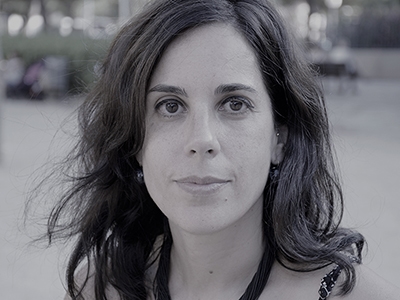September 13–October 10, 2018
Disseny HUB Museum Barcelona
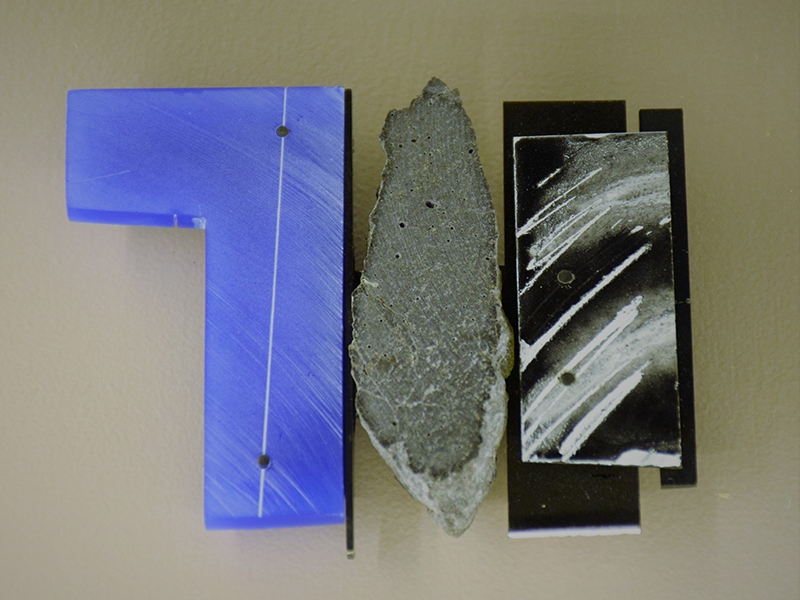
Quan la joia es fa metàfora (When the jewel becomes metaphor) was a major retrospective covering the last 33 years of Ramon Puig Cuyàs’s artistic career, organized by A-FAD and Joya Barcelona Art Jewellery & Objects as part of offjoya 2018. The journey, an intimate and revealing experience, took visitors through 194 extraordinary art jewels made by Puig Cuyàs while inviting them to get closer to the artist by joining him in his constant exploration of universal themes in search of a deeper sense of freedom and self-recognition.
The selection and presentation of the pieces shown at the retrospective enabled external beholders to feel that they were in front of 194 fragments of Puig Cuyàs’s reflective “self” before the world; 194 independent yet connected fragments of a perhaps unattainable and yet existing totality.
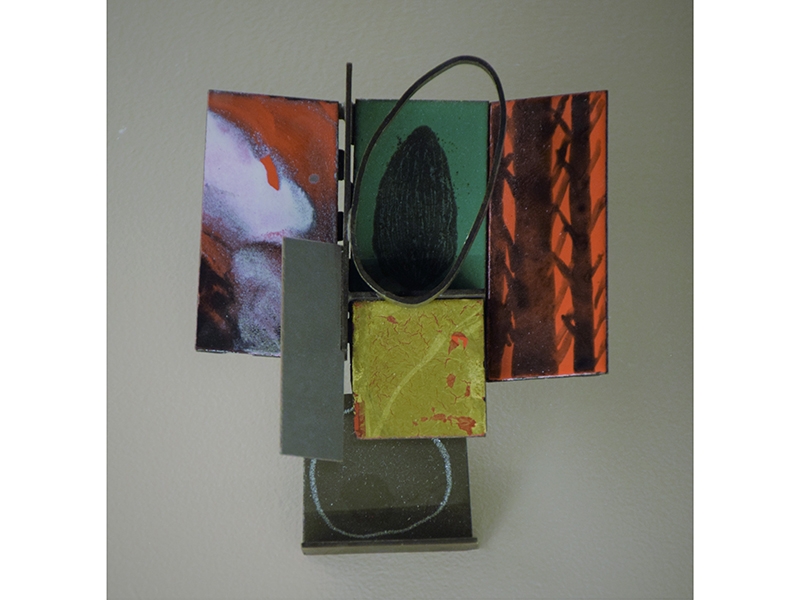
Curatorial Criteria
It is important to highlight that Quan la joia es fa metàfora was the first retrospective ever held on a living Spanish jewelry artist. Moreover, it must be added that it was a real honor to count on the artist’s presence and personal speech at the opening ceremony.
Although the exhibit was produced by Joya Barcelona, Puig Cuyàs himself was the person in charge of commissioning and curating it. In line with the show’s title, Puig Cuyàs’s main objective was to offer observers complete freedom to interpret and decipher the pieces by establishing their own connections.
Taking into consideration the dimensions and characteristics of the exhibition space (the B room of the Disseny Hub Museum, with a surface of 493 square meters), Puig Cuyàs decided to select 194 pieces from a total of 1,800 spanning from 1985 ’til the present time. The main curational criterion was to display a wide range of jewels presented under different series without following a chronological order. By doing this, Puig Cuyàs aimed at opening up the exhibit by inviting visitors to intuitively follow their own way and not by directing or influencing them.

Because there is no lineal evolution in Puig Cuyàs’s work due to the atemporal nature of his series, the intentionally “random” artwork display of Quan la joia es fa metàfora was not misleading in any way. There was no fixed itinerary, neither a center-periphery approach nor a justified beginning-middle-end journey. And, if metaphors are not merely ornamental but meaningful (as the philosopher Paul Ricoeur defended), it was the mission of viewers to enjoy, reflect, and try to decipher the multiple significations (metaphors) of the pieces by adding to them their own visions, experiences, and emotions, and by establishing polysemic connections rather than following a specific order to figure out some kind of time-bound evolution.
In this sense, although we widely believe that the artist overall managed to do so, and many pieces made it possible for viewers to freely unfold their wings, some other works (especially those with titles referring to mythology, philosophy, and art, or the ones in Latin) caused the task to be much more difficult and cryptic, as they required a deeper and broader knowledge. Consequently, as it was semantically not so easy to establish connections, viewers had to compensate for that difficulty by embracing the jewels from a visual or formal perspective, missing out on part of the possible significances.
Experiencing the Exhibit
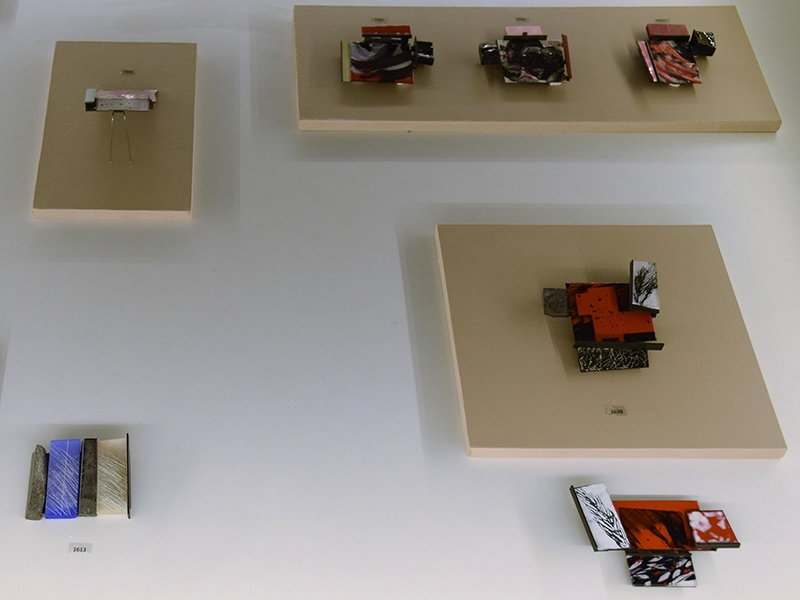
Source of the Pieces
They came from different sources, the main ones being the artist’s own collection and other private collections of jewelry lovers and collectors, for instance Maria Lluïsa Samaranch, Antònia Cortijos, and Heidi Bollmann.
Layout and Design
There was no catalog. No audiovisual material. No boards with texts or any kind of information that could condition the viewer’s experience. The self-contained 194 pieces were displayed in minimalist rectangular glass cabinets forming three cross-shaped islands with an indication of the piece and series title, date, and materials. Nothing else. The surrounding walls of the rectangular room were completely white and bare.
The darkness of the room was striking. There wasn’t anything out there. The only strong and affirmative light came from inside the cabinets, offering the jewels full prominence. This way, the space seemed to disappear in order to facilitate multiple silent dialogues between the viewers and the works of art.
Since the retrospective did not present the pieces following a chronological order, the fact that there were two main entrances to the room was not inconvenient. On the contrary, the experience of entering the space for the first time and seeing how other viewers were freely moving in and around the room was quite unique. One had the impression that the viewer was part of the artist’s last series, Maps to get lost in the woods. We had to find our own rhythm (map) within the chaos (woods).
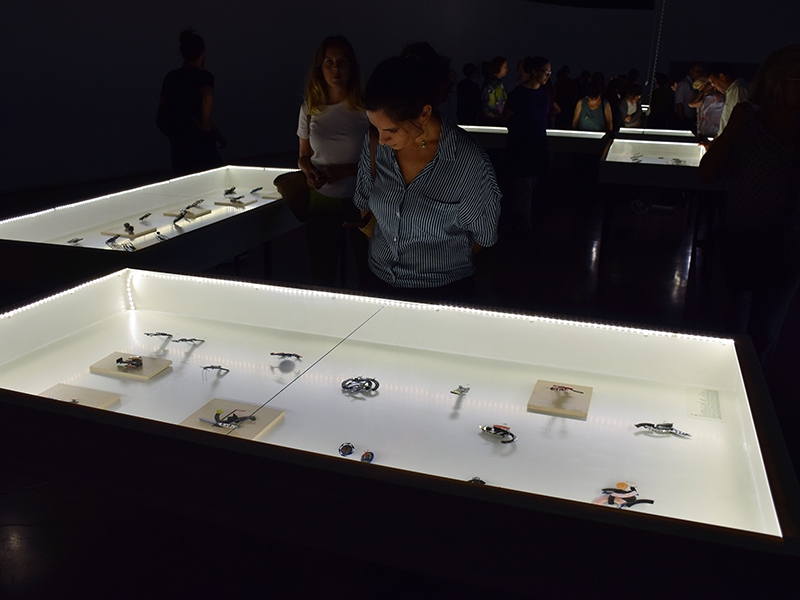
Series Displayed
The jewels exhibited at Quan la joia es fa metàfora belonged to the following series:
1985–1989 Senyors i senyores
1989–1995 Impressions of the Atlantis
1995–1997 Constellations
1997–2000 Archipelago
2001–2003 Cardinal marks
2004–2005 Walled gardens
2006–2007 Imago mundi
2007 Corpus architectae
2007–2009 Utopos
2009–2013 Net-work
2012–2016 Subtle architecture
2014–2016 Suite of Dresden
2014 Suite of Erfurt
2014 Suite city bird’s
2016–2017 Genesis: Tribute to Manfred Bischoff
2016 Suite Antartica
2016 Suite Pompeiana
2017–2018 Maps to get lost in the woods
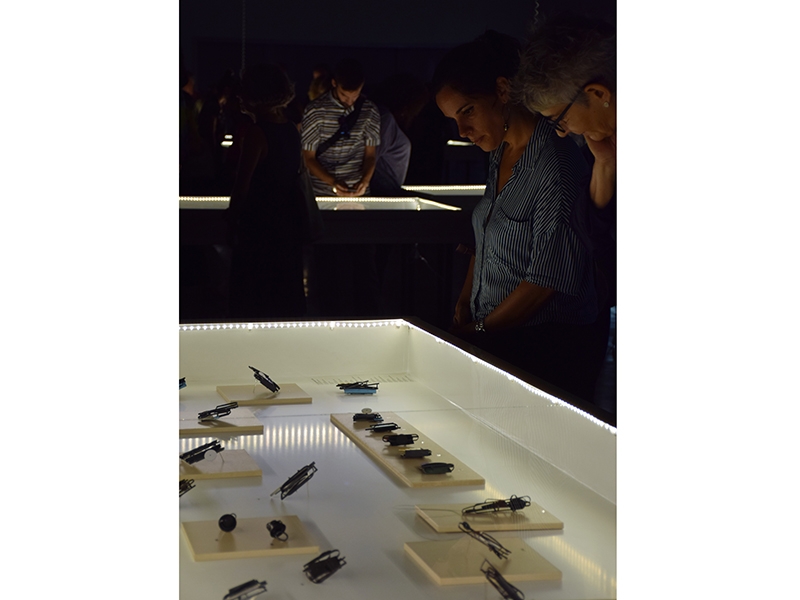
While we considered certain titles and their references or insinuations extremely beautiful due to their power to connect Puig Cuyàs’s art jewelry to universal themes that have been present in art, mythology, and philosophy throughout centuries, we would like to again briefly mention that it sometimes was not easy to make connections. Titles such as Utopos, Imago mundi or Genesis: Tribute to Manfred Bischoff and their connections to the pieces could have been a bit overwhelming to uninformed visitors without further textual information. In this sense, we believe that viewers were taking with them some homework in form of reflection or research, which of course is extremely interesting and denotes that they were in front of complete and complex masterpieces, but the consequence could have been a difficulty in bridging understanding and appealing to emotions.
Nevertheless, with the more autobiographical or personal series titles like Suite of Dresden or Walled gardens, viewers could easily let go and construct fictions or bridges with their own backgrounds.
Public
Although the exhibition was mainly disseminated via Joya’s and A-FAD’s channels, the retrospective managed to attract a diverse public as far as gender, age, nationality, and backgrounds are concerned. We believe that the fact that it took place at the Disseny HUB Museum, a multidisciplinary space for art, crafts, and design, was a crucial decision that achieved the diversity of visitors.
However, we still believe that such a relevant exhibit should have reached even more souls. Is this due to the fact that contemporary art jewelry is not accepted as contemporary art but as “minor” ornamental or applied arts? Is Barcelona not fostering and promoting contemporary jewelers? Why do events like this have little attention from cultural institutions, press, and (social) media? Does the public lack information and knowledge? We believe that it is a combination of all of this.

Type of Jewels/Objects
Almost all of the exhibited pieces were brooches, except for two rings (from the series Net-work) and a pair of earrings (from the Senyors i senyores series). Puig Cuyàs likes to work on brooches because they are not in direct contact with the body, since they are attached to clothes. Puig Cuyàs’s interest lies in the relation between the jewel and the person and not between the jewel and the body. Moreover, the brooch offers the artist a big enough surface to create, as if it were a canvas or a tridimensional sculpture.
Material
Puig Cuyàs is a poetic and philosophic artist who is not very much interested in experimenting with materials per se. This was evident to the viewer. The selection of heterogeneous materials that Puig Cuyàs used for his pieces seemed to be the result of conceptual and artistic decisions.
The real value of the jewels—mostly made of gold, silver, coral, plastic, wood, glass, enamel on steel (in his last series), or objets trouvés—lies in the intrinsic and conscious connection between the artist’s emotions and his personal form of materialization.
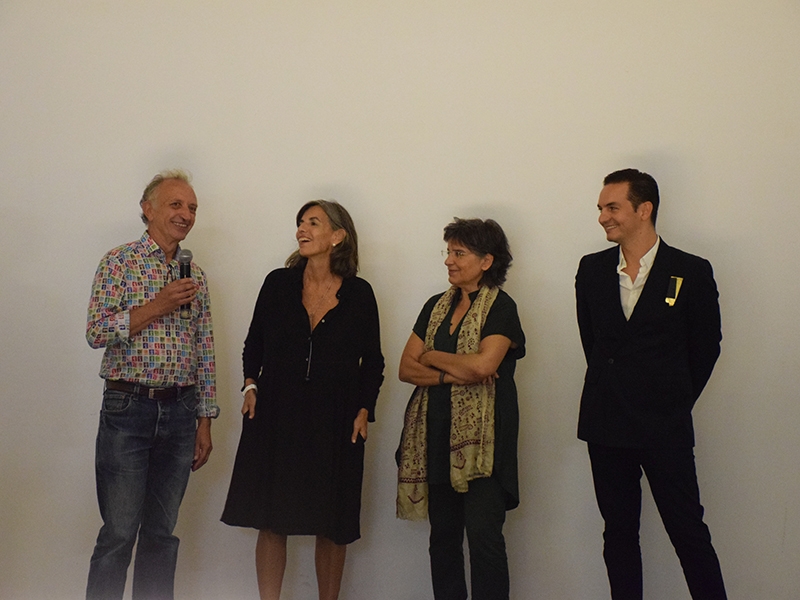
Form
Although one could perceive that the artist’s impulse to create was/is driven by a strong spiritual and hermeneutical force, the formal value of Puig Cuyàs’s artwork cannot be underestimated. Moreover, when the viewer was confronted by the opacity or difficulty of certain series titles, the fantastic visual effect of the pieces surely counteracted that feeling.
The 194 jewels shown at Quan la joia es fa metàfora are courageous, original, and reflective constructions characterized by clean lines and geometric shapes combining narrative and figurative elements. As for their color expressions and combinations, they made us think of renowned artists such as Paul Klee or Joan Miró. In all works there was a controlled freedom and rupture that captivated the public.
To conclude, we would like to express that Quan la joia es fa metàfora was an outstanding opportunity to get closer to a complete and unique jewelry thinker and artist who cannot fall under any conventional classification. Although as a viewer it was sometimes not easy to let go due to the complex intertextuality, added to the fact that one wanted to apprehend the 194 enlightened and enlightening masterpieces in one visit, we have to admit that it was an open and heterodox retrospective that empowered external beholders by inviting them to be part of the artistic process and go on researching and revisiting Puig Cuyàs’s work beyond the exhibit. Puig Cuyàs is certainly an artist who needs to be constantly rethought, reread, reinterpreted, revisited, and re-enjoyed.
Whether his pieces are considered artistic jewels, wearable sculptures, visual art, or evocative objects that explore and try to identify, translate, and rename the unobvious, the retrospective was certainly a unique and necessary tribute to one of the most coherent, intellectual, yet sensitive and poetic contemporary jewelry artists on the international scene.
